MSMEs in India’s Economic Growth
- 07 Feb 2025
In News:
In the Union Budget 2025–26, the Finance Minister proposed a significant policy shift by increasing the investment and turnover limits for MSME classification by 2.5 and 2 times respectively. This move is expected to enhance the growth prospects and scalability of India’s micro, small, and medium enterprises (MSMEs).
Economic Significance:
The MSME sector forms the backbone of the Indian economy, contributing 30% to the GDP and nearly 45% to manufacturing output. With over 1 crore registered units employing 7.5 crore people, it is the largest source of non-agricultural employment in the country. It plays a pivotal role in inclusive development, offering livelihood opportunities to the rural, urban poor, and semi-skilled workforce.
The formalization drive has been significant, with over 4 crore MSMEs registered on the Udyam portal by March 2024. Key schemes like PM Vishwakarma Yojana (?13,000 crore) and Mudra Yojana (?5.41 lakh crore disbursed in FY24) have supported artisans and first-time entrepreneurs, particularly women and marginalized communities.
Boost to Trade and Innovation:
MSMEs account for 45.73% of India’s total exports in sectors like textiles, leather, and engineering goods. Their integration into Global Value Chains (GVCs) is being facilitated by reforms in trade logistics, the GeM portal, and PLI schemes. Digital transformation is advancing rapidly, with 72% MSME transactions now digital, supported by platforms like ONDC and the RBI’s Public Tech Platform.
Women and Rural Empowerment:
Women entrepreneurs constitute 20.5% of Udyam registrations, and 68% of Mudra loans benefit them. MSMEs are also catalyzing rural industrialization by promoting agro-processing and curbing rural-urban migration through schemes like the SRI Fund and Animal Husbandry Credit Guarantee Scheme.
Key Challenges:
Despite their potential, MSMEs face critical bottlenecks:
- Credit access remains limited; only 20% of units access formal finance. Payment delays amounting to ?10.7 lakh crore (2022) hinder working capital.
- Regulatory burdens, inadequate infrastructure, and poor digital skills further constrain productivity.
- Low awareness of schemes and limited integration into global ESG standards affect competitiveness.
- The sector remains largely informal, weakening labor rights and policy outreach.
Recent Reforms & Recommendations:
To unlock MSMEs’ potential, a multi-pronged reform strategy is underway:
- Credit Measures: Promotion of cash-flow based lending, expansion of CGTMSE, Vyapar Credit Cards, and enhanced TReDS-GeM integration.
- Ease of Doing Business: Single-window clearances, self-certification, and stronger MSME facilitation councils.
- Digital & Skill Upgradation: Launch of Digital MSME 2.0, apprenticeship hubs, and innovation incubators.
- Market Access: Expansion of cluster-based models, branding support, and ONDC-GeM integration.
- Green MSMEs: ESG-linked credit, circular economy incentives, and green certifications.
- Formalization Push: Linking benefits to Udyam registration, backed by SIDBI-led equity support.
Conclusion:
MSMEs are central to India’s vision of a $5 trillion economy and Viksit Bharat by 2047. With increased investment thresholds, focused policy interventions, and digital empowerment, India can build a resilient, inclusive, and globally competitive MSME ecosystem.
Rapid Glacial Retreat in Arunachal Pradesh
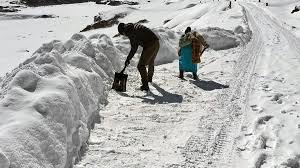
- 05 Feb 2025
In News:
A recent scientific study has revealed that the eastern Himalayas in Arunachal Pradesh have lost 110 glaciers between 1988 and 2020, highlighting a critical impact of climate change in the region.
Key Findings of the Study
- Glacier Loss: The number of glaciers declined from 756 to 646 over 32 years.
- Glacial Area Reduction: Total glacial cover reduced from 585.23 sq. km to 309.85 sq. km, indicating a loss of over 47%.
- Retreat Rate: Glaciers retreated at a rate of 16.94 sq. km per year.
- Elevation: Most glaciers were located at 4,500–4,800 metres above mean sea level on north-facing slopes of 15°–35°.
- Remote Sensing & GIS: The study used advanced tools along with the Randolph Glacier Inventory to track and analyze glacier boundaries.
- Glacial Lakes: Retreat has led to the formation of numerous glacial lakes, increasing the risk of Glacial Lake Outburst Floods (GLOFs), as seen during the 2023 Sikkim disaster which killed at least 55 people and damaged a 1,200 MW Teesta hydropower project.
Causes of Glacial Retreat
- Climate Change:
- The eastern Himalayas are warming faster than the global average.
- Temperature rise: Between 0.1°C and 0.8°C per decade.
- Over the last century, the region has experienced an increase of ~1.6°C.
- By 2100, projections indicate a 5–6°C temperature rise and 20–30% increase in precipitation.
- Black Carbon Deposition: Emissions from human activities (e.g., vehicles, biomass burning) deposit soot on ice, reducing reflectivity (albedo) and increasing heat absorption.
- Erratic Snowfall Patterns: Changes in precipitation reduce snow accumulation, weakening glacier sustenance.
- Geological Factors: Local topography, altitude, and rock composition also influence glacier stability and response to warming.
Implications of Glacial Retreat
- Water Security
- The Himalayas are known as the ‘Third Pole’, storing the largest volume of ice outside the polar regions.
- They are vital for sustaining over 1.3 billion people in South Asia by feeding major rivers (Indus, Ganga, Brahmaputra).
- Glacial retreat threatens long-term freshwater availability, agriculture, and urban water supplies.
- Hydropower and Infrastructure
- Changing river flow patterns due to glacial melt affect hydropower generation and irrigation systems.
- Risk of infrastructure damage from GLOFs is rising.
- Biodiversity and Agriculture: Altered ecosystems and climatic stress impact Himalayan biodiversity and disrupt traditional farming practices.
Himalayan Glaciers and River Systems
- Indus Basin: Originates from Lake Mansarovar; flows through Ladakh and Pakistan.
- Ganga Basin: Emerges from Gangotri Glacier in Uttarakhand; forms the Ganga after merging with Alaknanda.
- Brahmaputra Basin: Rises near Kailash range in Tibet; flows through Arunachal Pradesh, Assam, and Bangladesh.
Major Glaciers in India
Glacier Region Importance
Siachen Ladakh Longest glacier in India (76 km)
Gangotri Uttarakhand Source of the Ganga
Yamunotri Uttarakhand Origin of the Yamuna
Zemu Sikkim Largest glacier in Eastern Himalayas
Rathong Sikkim Feeds Teesta River
Milam Uttarakhand Source of Goriganga River
Pindari Uttarakhand Glacial trekking route
Glacial Lake Outburst Floods (GLOFs)
- GLOFs are sudden discharges of water from glacial lakes, often caused by moraine dam failures.
- These can trigger catastrophic downstream floods, threatening lives, infrastructure, and ecosystems.
Mitigation and Adaptation Strategies
- Climate Action: Drastic cuts in greenhouse gas emissions at national and global levels.
- Sustainable Water Management: Enhance glacier-fed river basin planning.
- Disaster Risk Reduction: GLOF early-warning systems, resilient infrastructure, and relocation policies.
- Community Participation: Local awareness, traditional knowledge integration, and eco-restoration efforts.
- International Cooperation: Transboundary initiatives under frameworks like the HKH (Hindu Kush Himalaya) Monitoring Network and UNFCCC.
RBI’s Liquidity Infusion of ?1.5 Lakh Crore

- 04 Feb 2025
In News:
In January 2025, the Reserve Bank of India (RBI) announced its largest monetary easing since the COVID-19 pandemic, unveiling a multi-pronged plan to inject over ?1.5 lakh crore into the money markets.
This move aims to address liquidity shortfalls caused by RBI’s forex interventions and signal possible easing in the upcoming monetary policy review.
Context: Why Liquidity Infusion Was Needed
- Forex Intervention: RBI sold over $50 billion from its foreign exchange reserves to stabilise the rupee, in response to large-scale equity sell-offs by Foreign Institutional Investors (FIIs).
- Impact: These interventions reduced rupee liquidity, tightened short-term interest rates, and raised borrowing costs.
- Liquidity Deficit: Market estimates pegged the shortfall at ?3 lakh crore.
Key Liquidity Measures Announced by RBI
- Government Bond Buy-Back: ?60,000 Crore
- Conducted in three tranches on January 30, February 13, and February 20, 2025.
- Objective: To inject liquidity into the banking system by repurchasing government securities before maturity.
- 56-Day Variable Rate Repo Auction: ?50,000 Crore
- Scheduled for February 7, 2025.
- Enables banks to borrow short-term funds by offering government securities as collateral at a market-determined interest rate.
- USD/INR Buy-Sell Swap Auction: $5 Billion
- A six-month forex swap in which RBI borrows dollars in exchange for rupees and agrees to buy them back later.
- Helps stabilize the rupee without draining rupee liquidity.
Significance of the Measures
- Monetary Transmission: With adequate liquidity, any potential repo rate cut will be more effectively transmitted through lower lending rates, boosting investment and consumption.
- Financial Stability: By calming money markets and moderating borrowing costs, RBI strengthens confidence amid global uncertainties.
- Rupee Management without Liquidity Squeeze: The forex swap allows rupee liquidity to remain intact while addressing exchange rate volatility.
Governor’s Focus Areas:
In a meeting with private sector bank heads ahead of the February monetary policy review, RBI Governor Sanjay Malhotra highlighted the following priorities:
- Financial Stability & Inclusion
- Enhanced Digital Literacy and Credit Access
- Improved Customer Service & Grievance Redressal
- Cybersecurity & IT Risk Management
- Monitoring of Third-party Service Providers
- Countering Rising Digital Fraud
Union Budget 2025–26
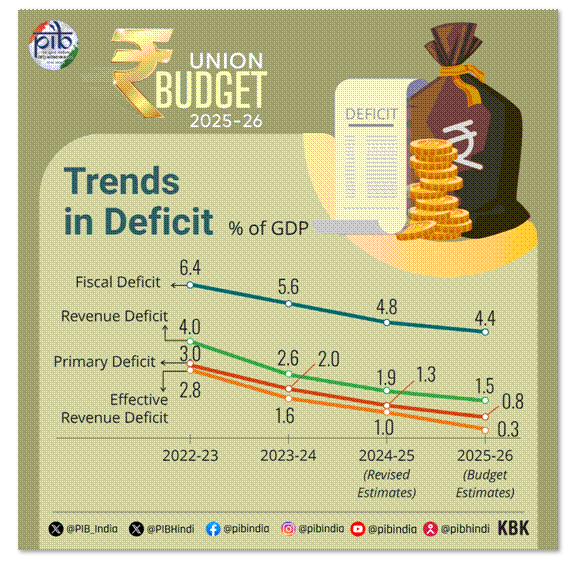
- 03 Feb 2025
In News:
Union Minister for Finance and Corporate Affairs Smt Nirmala Sitharaman presented Union Budget 2025-26 in the Parliament.
Key Highlights:
Fiscal Policy and Macroeconomic Indicators
- Total Expenditure: ?50.65 lakh crore
- Total Receipts (excl. borrowings): ?34.96 lakh crore
- Fiscal Deficit: 4.4% of GDP
- Gross Market Borrowing: ?14.82 lakh crore
- Capital Expenditure: ?11.21 lakh crore (3.1% of GDP)
Agriculture and Allied Sectors
- Prime Minister Dhan-Dhaanya Krishi Yojana: 100 low-productivity districts targeted; 1.7 crore farmers to benefit.
- Mission for Aatmanirbharta in Pulses: 6-year mission on Tur, Urad, and Masoor; NAFED/NCCF to procure for 4 years.
- Vegetables & Fruits Program: Comprehensive initiative for production, pricing, processing, and logistics.
- Makhana Board: New board in Bihar for production, value addition, and export.
- National Mission on High Yielding Seeds: To commercialize over 100 high-yielding seed varieties.
- Cotton Mission: 5-year initiative to boost productivity and Extra Long Staple (ELS) varieties.
- Fisheries: New EEZ and High Seas Framework focusing on Islands.
- Credit through KCC: Loan limit increased from ?3 lakh to ?5 lakh.
- Urea Plant in Assam: New plant at Namrup (12.7 lakh MT annual capacity).
MSMEs and Startups
- MSME Classification: Investment and turnover limits doubled (2.5x & 2x).
- Credit Cards for Micro Units: ?5 lakh limit; 10 lakh cards in year one.
- ?10,000 Cr Fund of Funds for Startups
- First-Time Entrepreneurs Scheme: Loans up to ?2 crore for 5 lakh women, SC/ST entrepreneurs.
- Footwear & Leather Sector Scheme: Aims ?4 lakh crore turnover and 22 lakh jobs.
- Toy Manufacturing Support: High-quality, eco-friendly toy ecosystem.
- Food Tech Institute: To be established in Bihar.
- National Manufacturing Mission: Across small, medium, and large units.
Infrastructure and Investment
- PPP Pipeline: 3-year project pipeline to be announced.
- ?1.5 lakh crore 50-year interest-free loans to states for CapEx.
- Urban Challenge Fund: ?1 lakh crore outlay; ?10,000 crore for FY26.
- Asset Monetization Plan 2025–30: Capital recycling worth ?10 lakh crore.
- Jal Jeevan Mission: Extended to 2028 with enhanced outlay.
- UDAN 2.0: Targeting 120 new destinations, 4 crore passengers in 10 years.
- Maritime Development Fund: ?25,000 crore; up to 49% govt contribution.
- Nuclear Energy Mission: ?20,000 crore outlay for Small Modular Reactors (SMRs).
- Greenfield Airports: Announced for Bihar.
Welfare and Social Security
- Saksham Anganwadi & Poshan 2.0: Enhanced nutritional cost norms.
- Medical Education: 10,000 new MBBS seats; 75,000 in 5 years.
- Day Care Cancer Centres: In all district hospitals; 200 in FY26.
- PM SVANidhi Revamp: ?30,000 UPI-linked credit cards.
- Online Platform Workers: E-Shram ID, PMJAY coverage.
- Urban Livelihood Scheme: For sustainable urban worker incomes.
Education and Skilling
- 50,000 Atal Tinkering Labs: Govt schools in 5 years.
- Bharatiya Bhasha Pustak Scheme: Digital books in Indian languages.
- National Skilling Centres of Excellence: With global partners.
- AI in Education: Centre of Excellence with ?500 crore outlay.
- IIT Expansion: Additional capacity for 6,500 students.
Innovation and R&D
- ?20,000 crore Innovation Fund (private-led R&D).
- Deep Tech Fund of Funds: For next-gen startups.
- PM Research Fellowships: 10,000 fellowships with higher support.
- 2nd Gene Bank: 10 lakh germplasm lines for food security.
- National Geospatial Mission
- Gyan Bharatam Mission: Conservation of 1 crore+ manuscripts.
Exports and Trade
- Export Promotion Mission: With ministerial and sectoral targets.
- BharatTradeNet (BTN): Unified platform for trade finance and docs.
- GCC Framework: Promote Global Capability Centres in Tier-2 cities.
Financial Sector Reforms
- FDI in Insurance: Raised from 74% to 100% for domestic investment.
- NaBFID Credit Enhancement Facility: For infra bonds.
- Grameen Credit Score: For SHGs and rural borrowers.
- Investment Friendliness Index: To rank states in 2025.
- Jan Vishwas Bill 2.0: Decriminalization of 100+ provisions.
- Tonnage Tax Extended: To inland vessels.
- Startups: Tax benefit eligibility extended to incorporation by 1 April 2030.
Taxation Reforms
Direct Taxes
- No Personal Tax: Income up to ?12 lakh (?12.75 lakh for salaried) under new regime.
- Revised Tax Slabs (New Regime):
- 0–4L: Nil | 4–8L: 5% | 8–12L: 10%
- 12–16L: 15% | 16–20L: 20% | 20–24L: 25% | 24L+: 30%
- Standard Deduction: ?75,000
- Compliance Relief: Trusts registration extended to 10 years.
- TDS/TCS Rationalization: Fewer thresholds, higher limits for senior citizens and rent.
- Tax Certainty: Safe harbour rules, startup extensions, presumptive taxation for electronics.
Indirect Taxes
- Tariff Rationalization: Only 8 remaining tariff rates.
- Customs Relief: ?2,600 crore forgone, key lifeline drugs exempted.
- Support to Domestic Manufacturing:
- EV/mobile battery manufacturing: 63 capital goods exempted
- Ships: BCD exemption extended for 10 years
- Marine, leather, textiles: Several BCD reductions/exemptions
- Voluntary Compliance Scheme: Without penalty for post-clearance corrections.
Geo-Economic Fragmentation (GEF)
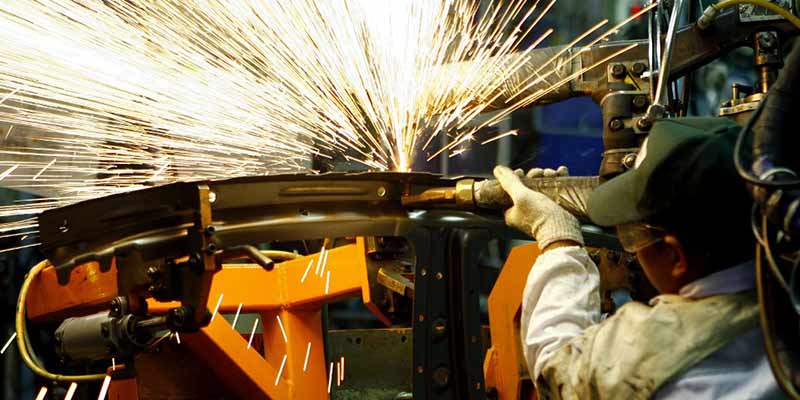
- 02 Feb 2025
In News:
Geo-economic fragmentation refers to a policy-driven reversal of global economic integration, increasingly shaped by geopolitical alignments. It signifies a shift from globalization to strategically-driven economic blocs, where nations prioritize political alliances over market efficiency.
Key Characteristics
- Emergence of friend-shoring, re-shoring, and economic nationalism.
- Fragmentation of trade, capital flows, FDI, and migration.
- Retreat from multilateralism, with institutions like the WTO and IMF under stress.
- Strategic use of environmental, labor, and social standards by developed countries to impose uniform regulations, causing tensions.
Globalization to Fragmentation: Statistical Evidence
- Trade-to-GDP Ratio: Increased from 39% (1980) to 60% (2012); now threatened by rising protectionism.
- FDI Inflows: Rose from $54 billion (1980) to $1.5 trillion (2019); now increasingly concentrated among like-minded countries.
- Global Economy: Expanded from $11 trillion (1980) to over $100 trillion (2022).
- Trade Restrictions (WTO Report):
- 2023–24: 169 new measures covering $887.7 billion in trade.
- 2022–23: Covered $337.1 billion — shows a dramatic rise in protectionism.
- Over 24,000 new trade and investment restrictions imposed globally between 2020–24.
IMF on Costs of GEF
- Trade fragmentation could cause 0.2% to 7% GDP losses, especially for developing countries.
- Current fragmentation is more costly than Cold War era, as trade now constitutes 45% of global GDP (vs. 16% then).
- Less trade = less knowledge diffusion, innovation, and productivity gains.
Strategic Impacts: Global Supply Chains
China’s Dominance
- 80% of global battery manufacturing.
- 80% of solar panel components.
- 60% of wind turbine capacity.
- 70% of global rare earth mineral processing.
- Dominates EV supply chains, critical mineral refining, and clean energy manufacturing.
FDI Realignment
- FDI is increasingly relocating from China to India, Vietnam, Mexico, etc.
- Friend-shoring reduces capital access for emerging markets.
- Emerging economies face reduced FDI, slower growth, and technological decoupling.
India’s Strategic Response: Deregulation and Internal Growth
Policy Recommendations (Economic Survey 2024–25)
- Amplify deregulation to lower compliance costs and boost entrepreneurship.
- Empower SMEs to withstand global shocks and strengthen domestic manufacturing.
- Encourage inter-state learning for best practices in economic governance.
- Redouble efforts to boost exports and foreign investment amidst global volatility.
Rationale
- With the decline of global cooperation, internal engines of growth become crucial.
- Deregulation can unleash innovation, enhance productivity, and ensure resilient growth.
- India's response must be strategic, systematic, and state-inclusive to capitalize on this global transition.
Economic Survey 2024–25
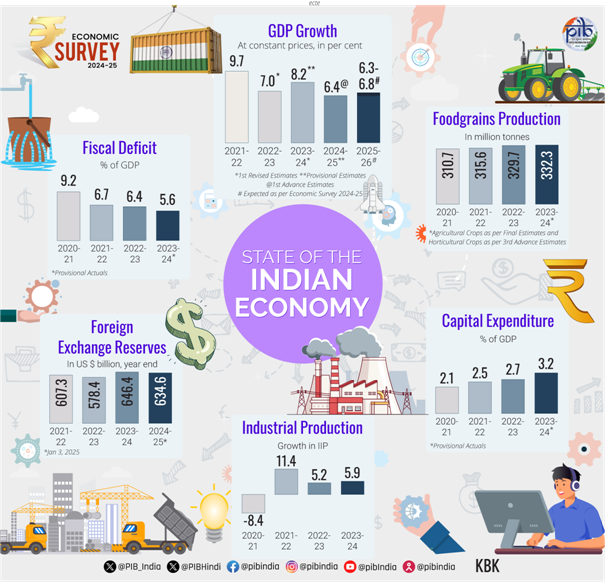
- 01 Feb 2025
In News:
- Released on 31st January 2025, a day before the Union Budget.
- Prepared by the Department of Economic Affairs, Ministry of Finance.
- Provides a comprehensive review of India’s macroeconomic trends, sectoral developments, and key policy challenges.
- Real GDP growth estimated at 6.4% in FY25 (close to decadal average); projected between 6.3–6.8% in FY26.
- Reflects India's resilience amidst global slowdown, supply chain disruptions, and geopolitical uncertainties.
Sector-wise Performance
Agriculture:
- Expected growth: 3.8% in FY25.
- Record Kharif foodgrain production: 1647.05 LMT (+5.7% YoY).
- Growth driven by horticulture, livestock, and fisheries.
- Supported by above-normal monsoons and robust reservoir levels.
Industry:
- Estimated growth: 6.2% in FY25.
- Construction, utilities, and mining contribute significantly.
- Challenges: Sluggish export demand, climate disruptions, and festival timing variations.
- Manufacturing PMI remains in the expansionary zone.
Services:
- Robust growth: 7.2% in FY25.
- Services exports up by 12.8% (April–Nov FY25) vs 5.7% in FY24.
- Growth led by finance, real estate, public administration, and professional services.
Inflation and Price Stability
- Retail inflation eased to 4.9% (Apr–Dec 2024) from 5.4% (FY24).
- Food inflation remains high at 8.4%, driven by pulses and vegetables.
- CPI expected to align with RBI's 4% target by FY26.
Investment and Infrastructure
- Capital Expenditure grew 8.2% YoY (Jul–Nov 2024); sustained increase since FY21.
- Infrastructure momentum:
- 2031 km railways commissioned (Apr–Nov 2024).
- 17 Vande Bharat trains introduced.
- Port efficiency improved; container turnaround time reduced from 48.1 to 30.4 hours.
- Renewable energy capacity rose by 15.8% YoY (Dec 2024).
External Sector and Trade
- Overall exports grew by 6% (Apr–Dec 2024); merchandise exports up 1.6%.
- Services exports surged; India now 7th largest globally.
- FDI inflows: $55.6 billion (Apr–Nov FY25), +17.9% YoY.
- Forex reserves at $640.3 billion (Dec 2024), covering 10.9 months of imports and 90% of external debt.
- CAD contained at 1.2% of GDP in Q2 FY25.
- Strong remittance inflows support BOP stability.
Fiscal Health
- Gross Tax Revenue rose 10.7% YoY (Apr–Nov 2024).
- Stable deficit indicators allowed for developmental expenditure.
- State revenue expenditure grew 12%, with subsidies increasing by 25.7%.
Banking, Credit, and Financial Markets
- Gross NPAs dropped to 2.6% (lowest in 12 years).
- CRAR of scheduled banks at 16.7% (Sept 2024), well above regulatory norms.
- Stock market cap to GDP ratio: 136%, higher than China (65%) and Brazil (37%).
- Credit-GDP gap reduced to -0.3% in Q1 FY25 (from -10.3% in Q1 FY23).
Employment and Labour Market
- Unemployment rate declined to 3.2% (2023-24) from 6.0% (2017-18).
- Labour Force Participation Rate (LFPR) and Worker-Population Ratio (WPR) improved.
- Emphasis on AI skill development to future-proof labour markets.
Health, Education & Social Sector
- Government health expenditure rose from 29% to 48% of total health spending (FY15–FY22).
- Out-of-pocket expenditure dropped from 62.6% to 39.4% in the same period.
- Education reforms aligned with NEP 2020 via programs like Samagra Shiksha, DIKSHA, PM SHRI, etc.
- Social services spending grew at 15% CAGR (FY21–FY25).
- Decline in Gini coefficient indicates improving consumption equality.
Policy Recommendations and Reform Agenda
- Deregulation as central theme to boost productivity and EoDB.
- Advocates Ease of Doing Business 2.0, led by states, targeting:
- Simplification of compliance norms.
- Risk-based regulation.
- Reduction in tariffs and licensing hurdles.
- ?50,000 crore Self-Reliant India Fund launched for MSME equity support.
- Need for long-term infrastructure investment to achieve Viksit Bharat@2047.
Global Backdrop
- Global GDP grew by 3.3% in 2023, with an average 3.2% growth projected over next five years (IMF).
- Weak global manufacturing; services sector remains stronger.
- Risks: Geopolitical tensions, trade policy fragmentation, energy transition dependence on China.
Way Forward
- Balanced outlook for FY26 with upside from:
- Strong rural demand.
- Agricultural recovery.
- Easing food inflation.
- Challenges include:
- Geopolitical tensions.
- Global trade and commodity price volatility.
- Delay in private investment materialisation.
Addressing Environmental Challenges and Strengthening Regulations in India
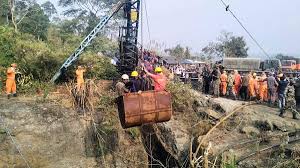
- 28 Jan 2025
In News:
India's recent coal mining tragedy in Dima Hasao, Assam, underscores the nation's ongoing struggle with illegal and hazardous rat-hole mining, despite the National Green Tribunal's 2014 ban. This persistent exploitation, driven by industrial demand for coal, highlights the gap between environmental regulations and their enforcement, revealing a broader issue of balancing economic growth with environmental protection. As India strives to meet ambitious climate goals and sustain economic development, strengthening environmental regulations becomes critical.
Current Environmental Regulations in India
India has established a strong legal framework to protect its environment, grounded in the Indian Constitution. Articles 48A and 51A(g) direct the state and citizens to safeguard the environment, while Article 21 ensures the right to a clean and healthy environment, as interpreted by the Supreme Court. Key pollution control laws include:
- Water (Prevention and Control of Pollution) Act, 1974: Regulates water pollution and establishes pollution control boards at the national and state levels.
- Air (Prevention and Control of Pollution) Act, 1981: Controls air pollution from industrial emissions and vehicles.
- Environment (Protection) Act, 1986: Provides overarching powers for environmental protection.
- Plastic Waste Management Rules, 2016: Regulates plastic waste disposal and bans single-use plastics.
Other significant laws focus on forest and wildlife protection, including the Indian Forest Act, 1927, and the Wildlife (Protection) Act, 1972, along with the National Green Tribunal (NGT) Act, 2010, which ensures quick resolution of environmental disputes.
Key Issues with Enforcement
- Despite these stringent regulations, enforcement remains weak due to institutional limitations. Many industrial units fail to meet environmental standards, with regulatory bodies underfunded and understaffed. For example, pollution control boards in states like Uttar Pradesh and Bihar are plagued by staffing shortages, hampering their ability to monitor pollution effectively.
- Inadequate public participation and insufficient technology adoption further exacerbate these challenges.
- The Environmental Impact Assessment (EIA) process, often bypassed or diluted, leads to development projects being approved without full consideration of their environmental impacts, particularly in ecologically sensitive areas.
Weak Enforcement and Conflict between Development and Conservation
The tension between development and conservation is evident in policies that relax environmental regulations for economic growth. The Forest (Conservation) Amendment Act, 2023, prioritizes infrastructure projects over forest preservation, undermining ecological conservation. Moreover, the rapid urbanization of cities like Gurugram and Faridabad has led to large-scale deforestation and a reduction in natural conservation zones, worsening air and water quality.
Strengthening Environmental Regulations
To address these challenges, India needs to strengthen its environmental regulatory mechanisms:
- Enhance Enforcement: Adequate funding, skilled personnel, and advanced technology, such as AI-based pollution monitoring and drone surveillance, are essential to improve compliance.
- EIA Reforms: The EIA process should be made more transparent and participatory, ensuring that marginalized communities are included in decision-making.
- Promote Clean Energy: Expanding subsidies for renewable energy and encouraging industries to adopt green technologies will help reduce reliance on fossil fuels.
- Circular Economy: Encouraging industries to adopt recycling and upcycling practices can minimize waste and reduce resource extraction.
- Strengthen Local Involvement: Empowering local communities through decentralization under the Forest Rights Act will ensure more inclusive environmental governance.
Conclusion
India’s environmental challenges require a balanced approach, integrating sustainable development with robust environmental protections. Strengthening regulatory enforcement, reforming the EIA process, and fostering community-led conservation are essential to aligning economic growth with environmental sustainability. By addressing these gaps, India can better navigate its path toward achieving both its development goals and climate commitments.
External Commercial Borrowings (ECBs)
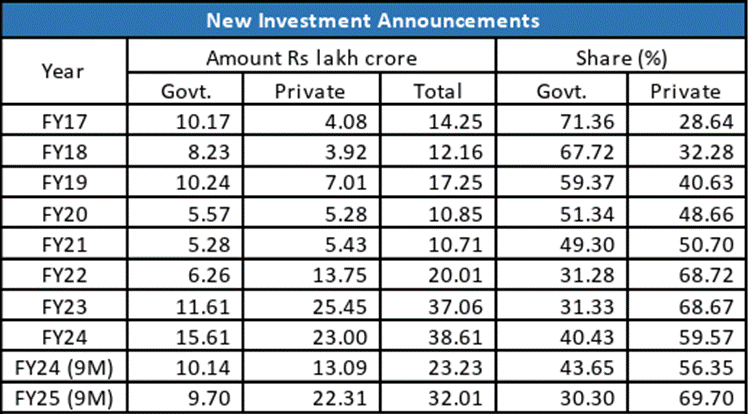
- 25 Jan 2025
In News:
A recent State Bank of India (SBI) report highlights the evolving trends in investment activity and the increasing importance of External Commercial Borrowings (ECBs) in financing India's economic growth. It also reflects rising private sector participation and a robust capital formation trend.
Investment Trends in India:
- Total Investment Announcements reached ?32.01 lakh crore during April–December 2024 (9MFY25), up 39% from the same period in FY24.
- The private sector accounted for 70% of investments in 9MFY25, up from 56% in FY24, indicating rising business confidence.
- Gross block of Indian corporates rose to ?106.5 lakh crore (March 2024), from ?73.94 lakh crore in March 2020—an addition of over ?8 lakh crore annually.
- Capital Work in Progress stood at ?13.63 lakh crore, reflecting ongoing infrastructure and industrial projects.
- Household Net Financial Savings (HNFS) improved to 5.3% of GDP in FY24 from 5.0% in FY23.
- Investment-to-GDP ratio improved, with:
- Government investment at 4.1% of GDP (FY23) — highest since FY12.
- Private corporate investment rising to 11.9% in FY23, projected to reach 12.5% in FY24.
What are External Commercial Borrowings (ECBs)?
ECBs refer to loans raised by Indian entities from foreign lenders, including commercial banks, export credit agencies, and institutional investors. These borrowings are regulated by the Reserve Bank of India (RBI) and used for purposes like capital expansion, modernization, and infrastructure development.
Current Status of ECBs (as of Sept–Nov 2024):
- Outstanding ECBs stood at $190.4 billion (Sept 2024).
- Private sector share: 63% (~$97.6 billion).
- Public sector share: 37% (~$55.5 billion).
- Of the total, non-Rupee and non-FDI ECBs accounted for $154.9 billion.
- ECBs registered (April–Nov 2024): $33.8 billion, mainly for capital goods import, local capex, and new projects.
- Cost of ECBs declined to:
- 6.6% average during April–November 2024.
- 5.8% in November 2024, down by 71 basis points from the previous month.
- Hedging practices: Private companies hedge about 74% of their ECB exposure, essential for managing currency risk.
Why Are ECBs Important for India?
- Bridging Capital Gaps: Domestic markets may not meet the capital needs of large projects.
- Lower Interest Rates: ECBs often offer cheaper financing than domestic loans.
- Infrastructure Financing: Key source of funds for sectors needing long-term investment.
- Foreign Exchange Access: Supports imports, modernization, and technology adoption.
- Private Sector Expansion: Enables firms to grow, diversify, and remain globally competitive.
Challenges and Risks:
- Currency Risk: Rupee depreciation can raise repayment costs.
- Interest Rate Risk: Linked to global rates (e.g., LIBOR/SOFR), which can rise unpredictably.
- Hedging Costs: Though necessary, hedging adds to borrowing costs.
- Global Dependency: Exposure to international financial volatility.
- Regulatory Constraints: RBI norms on end-use, maturity, and cost ceilings can reduce flexibility.
- Over-Borrowing Risk: Mismanagement can lead to unsustainable debt levels and strain forex reserves.
Clarification on ECB Liability Data:
- Some media reports mistakenly cited India’s ECB stock as $273 billion.
- The actual ECBs, as per RBI (Sept 2024), stand at $190.4 billion.
- The inflated figure includes $72 billion in FPI (Debt), which should not be classified as ECBs.
Way Forward:
- Regulatory Refinement: Simplify ECB rules for strategic sectors and long-term projects.
- Encourage Hedging: Make risk management more affordable and accessible.
- Prudent Borrowing: Promote ECBs for infrastructure, exports, and modernization rather than working capital.
- Monitoring and Oversight: Ensure transparency and prevent over-leverage.
- Strengthen Domestic Financing: To reduce overdependence on foreign borrowing.
India’s Renewable Energy Revolution
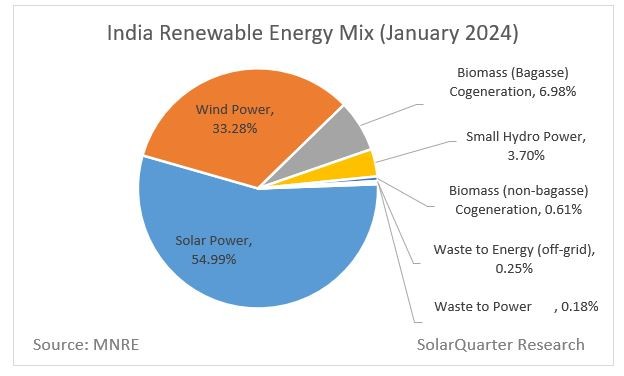
- 22 Jan 2025
Introduction
India's transition towards clean energy has accelerated, with 2024 witnessing record-breaking renewable energy (RE) installations and policy innovation. With a vision to achieve 500 GW of non-fossil fuel capacity by 2030 and net-zero emissions by 2070, India is shaping itself as a global leader in sustainable development.
What is Renewable Energy?
Renewable energy is derived from naturally replenishing sources like solar, wind, hydropower, and biomass. It plays a vital role in:
- Reducing dependence on fossil fuels.
- Lowering greenhouse gas emissions.
- Ensuring long-term energy security.
India’s RE Targets and Progress
Parameter Target/Status
2030 Target 500 GW of non-fossil fuel capacity
Net Zero by 2070
Current Status (Jan 2025) 217.62 GW of non-fossil fuel-based capacity
Short-term Goal 50% energy capacity from renewable sources
2024: Year of Renewable Milestones
Solar Energy
- 24.5 GW added in 2024 — a 2.8x increase over 2023.
- 18.5 GW utility-scale solar: Rajasthan, Gujarat, Tamil Nadu contributed 71%.
- Rooftop Solar:
- 4.59 GW added (↑53%)
- 7 lakh installations under PM Surya Ghar: Muft Bijli Yojana.
- Off-grid Solar:
- 1.48 GW added (↑182%), promoting rural energy access.
Wind Energy
- 3.4 GW added: Gujarat (1,250 MW), Karnataka (1,135 MW), Tamil Nadu (980 MW) = 98% of new capacity.
Hydropower & Others
- Existing hydropower plants modernized to improve efficiency.
Government Initiatives Driving Growth
Scheme/Initiative Purpose
PM Surya Ghar: Muft Bijli Yojana Rooftop solar subsidies for households
Green Energy Corridor (GEC) Transmission infra for RE-rich states
Hydrogen Energy Mission Promote green hydrogen production
National Smart Grid Mission (NSGM) Integration of variable RE sources into the grid
FAME Scheme Promote EV adoption, indirectly supporting RE usage
International Solar Alliance (ISA) Strengthen global cooperation in solar energy
Challenges in RE Expansion
- Land Acquisition: Resistance from locals, especially in solar park areas.
- Grid Stability: Intermittency of solar/wind leads to voltage and frequency issues.
- Storage Gaps: Lack of large-scale battery storage limits surplus utilization.
- E-Waste Concerns: Rising disposal of solar panels and batteries.
- Mineral Dependency: Import reliance on lithium, cobalt, etc.
- Regulatory Bottlenecks: Delay in approvals and lack of inter-state coordination.
Way Forward: Strategic Interventions
Technological Innovation
- Floating Solar Projects: Utilize reservoirs to save land and reduce evaporation.
- Decentralized Systems: Peer-to-peer trading via blockchain for energy democratization.
- Green Hydrogen: Use surplus RE for hydrogen fuel, develop hydrogen corridors.
Infrastructure & Manufacturing
- Renewable Energy SEZs: Promote local manufacturing and innovation.
- Smart Grid Development: Improve grid flexibility and real-time balancing.
Environmental Management
- Circular Economy for RE Waste: Design policies for solar panel and battery recycling.
- Urban Integration: Incentivize rooftop installations in urban centers.
Conclusion
India’s renewable energy revolution is at a crucial juncture. With 2024 setting a strong precedent through record installations and policy progress, the path to 2030 and beyond will require addressing infrastructural, financial, and regulatory challenges. A multi-pronged, inclusive, and technology-driven approach will help India lead the global clean energy transition.
Satellite Docking Experiment (SpaDeX)
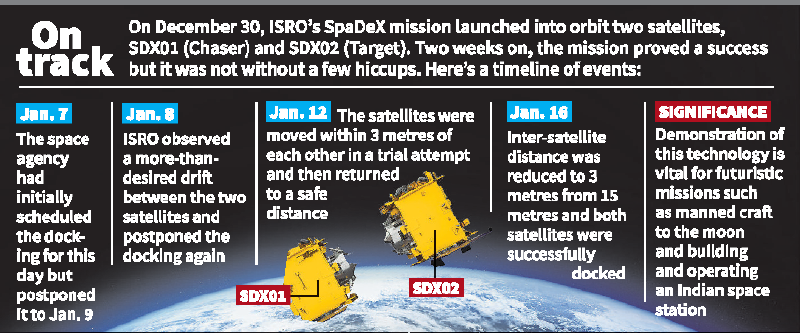
- 17 Jan 2025
In News:
The Indian Space Research Organisation (ISRO) achieved a historic milestone by successfully executing a satellite docking experiment, making India the fourth country after the United States, Russia, and China to accomplish this feat. This advancement represents a significant leap in India's space capabilities, positioning the nation at the forefront of space exploration and in-orbit servicing.
Key Highlights:
- The Space Docking Experiment (SpaDeX) is a critical technological demonstration by ISRO aimed at developing autonomous docking and undocking capabilities in space.
- The mission involves two satellites, SDX01 (Chaser) and SDX02 (Target), which were launched aboard PSLV C60 on December 30, 2024.
- The docking maneuver was overseen by the Mission Operations Complex (MOX) at the ISRO Telemetry, Tracking, and Command Network (ISTRAC) and was successfully completed in the early hours of January 18, 2025.
Key Steps in the Docking Process:
- Manoeuvre from 15m to 3m hold point.
- Precision docking initiation, leading to spacecraft capture.
- Retraction and rigidization for stability.
- Successful control of the docked satellites as a single object.
Significance of the Mission
- Technological Advancement: The docking of two spacecraft in orbit is a crucial capability that paves the way for:
- Autonomous spacecraft operations
- Refueling and maintenance of satellites
- Space station development
- Lunar and interplanetary missions
Future Applications
- Manned Missions: Enables India to develop technology for manned lunar missions and future space station operations.
- Satellite Servicing: Allows repair, maintenance, and extension of satellite lifespan, reducing costs and space debris.
- Sample Return Missions: Essential for lunar and planetary sample retrieval, crucial for deep-space exploration.
Challenges and Overcoming Setbacks
The SpaDeX docking was initially scheduled for January 7, 2025, but was postponed due to the need for further ground validation and an unexpected drift between the satellites. The issue was later resolved, and the docking was executed with precision.
The Road Ahead
Undocking and Power Transfer Demonstration
- ISRO will follow up with power transfer checks between the docked satellites.
- The satellites will later undock and operate separately for the remaining mission duration of up to two years.
Expanding Space Capabilities
- The successful execution of SpaDeX aligns with India’s plans for an independent space station by the 2030s.
- Strengthens India’s position in international space collaborations and commercial space services.
Conclusion
The SpaDeX mission represents a landmark achievement for India’s space program, placing it among the elite nations capable of satellite docking. This breakthrough will serve as a foundation for India’s ambitious future missions, including deep-space exploration, human spaceflight, and interplanetary research. As ISRO continues to develop advanced space technologies, India is set to play a crucial role in the future of global space exploration.
Genome India Project

- 14 Jan 2025
In News:
The Genome India Project is an ambitious national initiative aimed at decoding the genetic diversity of India’s population. Launched in January 2020 by the Department of Biotechnology (DBT), the project seeks to create a comprehensive map of India’s genetic variations, offering insights that can revolutionize public health, medicine, and our understanding of human genetics.
What is Genome Sequencing?
Genome sequencing is the process of determining the complete DNA sequence of an organism’s genome. The human genome, composed of about 3 billion base pairs of DNA, contains all the genetic instructions necessary for the growth, development, and functioning of the human body. The process involves extracting DNA from a sample (often blood), breaking it into smaller fragments, and using a sequencer to decode these fragments. The data is then reassembled to reconstruct the full genome.
Key Aims and Objectives
The Genome India Project aims to address several crucial scientific and healthcare challenges:
- Create an Exhaustive Catalog of Genetic Variations: This includes common, low-frequency, rare, and structural variations (such as Single Nucleotide Polymorphisms or SNPs).
- Establish a Reference Haplotype Structure: This reference panel will be used for imputing missing genetic variations in future genetic studies.
- Design Affordable Genome-wide Arrays: These arrays will be useful for research and diagnostics at a lower cost, making genetic analysis accessible.
- Create a Biobank for Future Research: The collected DNA and plasma will be preserved for future studies to facilitate ongoing genetic research.
Genome India Project: Phase 1 and Key Findings
The project’s Phase 1 focused on sequencing the genomes of 10,074 individuals from 99 ethnic groups across India. This initiative provides a critical baseline for studying the country’s genetic diversity. Some of the key findings include:
- 459 plant species have been identified as part of genetic diversity studies.
- 135 million genetic variations have been uncovered, including 7 million that are unique to India, not found in global databases.
- The project has revealed several genetic risks specific to Indian populations, such as the MYBPC3 mutation (linked to cardiac arrest) and the LAMB3 mutation (associated with a lethal skin condition), which are not commonly seen in global datasets.
This database will serve as a vital resource for researchers, contributing to the development of precision medicine, better disease diagnosis, and more personalized treatments.
Second Phase: Expanding the Scope
The second phase of the Genome India Project will focus on sequencing the genomes of individuals suffering from specific diseases. This will enable researchers to:
- Compare the genomes of healthy individuals with those having diseases, helping identify genetic mutations responsible for conditions like cancer, diabetes, and neurodegenerative diseases.
- Investigate rare diseases specific to Indian populations and develop therapies tailored to these conditions.
By sequencing the genomes of individuals with various conditions, the project aims to pinpoint genetic factors that contribute to the pre-disposition or causation of diseases.
Data Sharing and Security
To ensure data security and privacy, the genetic information will be made available only through managed access. Researchers interested in using the data will need to submit a proposal and collaborate with the Department of Biotechnology. The data will be stored securely at the Indian Biological Data Centre (IBDC) in Faridabad, Haryana, and anonymized to maintain confidentiality.
Why Does India Need Its Own Genetic Database?
India is home to a highly diverse population, with over 4,600 distinct ethnic groups and varying genetic backgrounds. The country’s genetic diversity, shaped by its geographical, cultural, and historical context, cannot be fully understood through datasets derived from other countries. The Genome India Project helps:
- Identify Genetic Risk Factors: For various diseases, paving the way for developing targeted diagnostic tools and therapies.
- Uncover Unique Variants: Some genetic mutations found in India, such as the Vaishya community’s resistance to anaesthetics, are absent in global databases.
- Address Population-specific Health Issues: Genetic mapping enables the identification of prevalent diseases and health conditions specific to Indian populations.
Global Context and Comparison
India’s genome sequencing effort is part of a larger global movement in genomics:
- Human Genome Project (2003): The first international effort to decode the human genome.
- 1,000 Genome Project (2012): Published 1,092 human genome sequences.
- UK 100,000 Genome Project (2018): Sequenced 100,000 genomes for health research.
- European Genome Project: Aims to sequence over 1 million genomes across 24 countries.
The Genome India Project fills a crucial gap by focusing on the genetic diversity of Indian populations, which differs significantly from the genetic profiles studied in Western or European genomes.
Applications of Genome India Project
The Genome India Project has the potential to impact multiple areas:
- Advancements in Medicine: Understanding genetic variations can lead to the development of personalized medicine, where treatments are tailored to individual genetic profiles.
- Genetic and Infectious Disease Control: The project helps identify genetic resistance to diseases, and aids in understanding how certain populations may respond differently to drugs or vaccines.
- Public Health Policies: Data from the project can inform health policies, especially in tackling diseases prevalent in specific regions or communities.
- International Research Collaboration: The project aims to foster collaboration with global research communities, enhancing India’s presence in the field of genomics.
Conclusion:
The Genome India Project is a landmark initiative for India’s scientific community, enabling better understanding of the country’s genetic diversity and paving the way for breakthroughs in medicine, healthcare, and disease prevention. The ability to analyze genetic variations on such a large scale provides immense opportunities for precision medicine and personalized treatments.
Rat-hole mining
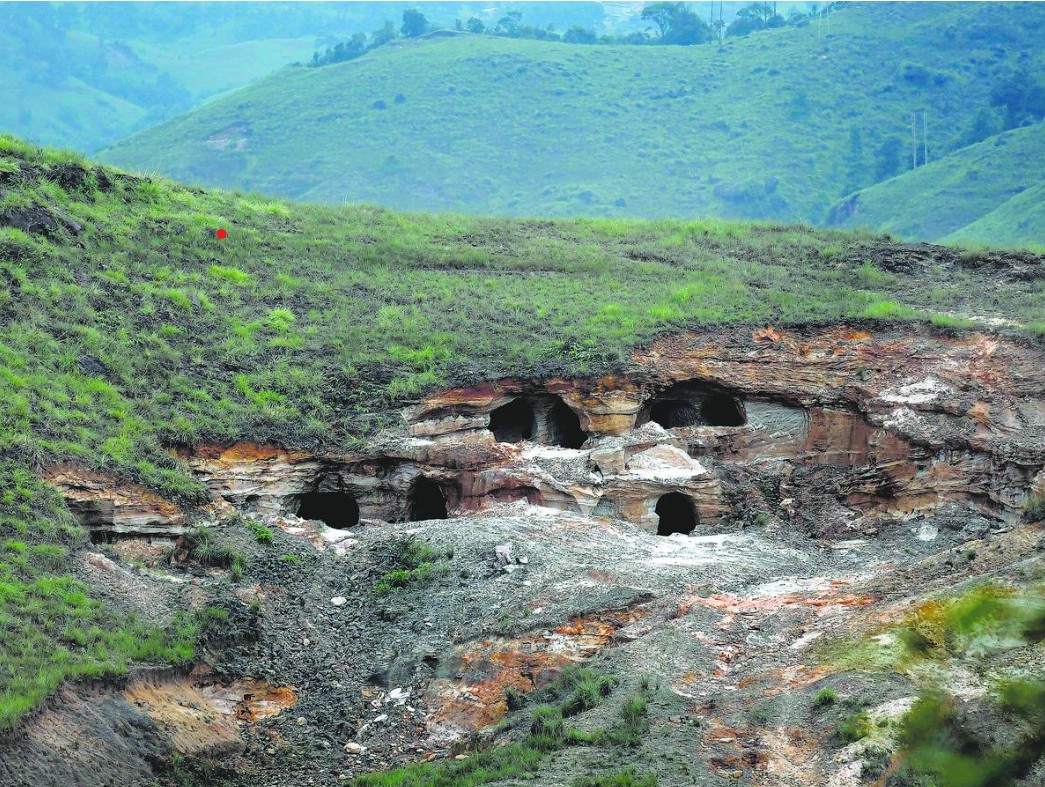
- 13 Jan 2025
In News:
In Dima Hasao district of Assam, at least nine workers aged between 26 and 57 were trapped in a coal “rat-hole” mine after it was flooded with water. Three miners trapped in a flooded coal mine were confirmed dead, while six remained stuck. Later an Indian Navy team, including deep-sea divers, arrived at the site, where the water level inside the pit is 200 feet deep.
Key Takeaways:
- Rat-hole mining is a method of extracting coal from narrow, horizontal seams, prevalent in Meghalaya. The term “rat hole” refers to the narrow pits dug into the ground, typically just large enough for one person to descend and extract coal.
- Once the pits are dug, miners descend using ropes or bamboo ladders to reach the coal seams. The coal is then manually extracted using primitive tools such as pickaxes, shovels, and baskets.
- Types of Rat-hole mining:
- Side-cutting mining: In the side-cutting procedure, narrow tunnels are dug on the hill slopes and workers go inside until they find the coal seam. The coal seam in the hills of Meghalaya is very thin, less than 2 m in most cases.
- Box-cutting mining: In the other type of rat-hole mining, called box-cutting, a rectangular opening is made, varying from 10 to 100 sqm, and through that a vertical pit is dug, 100 to 400 feet deep. Once the coal seam is found, rat-hole-sized tunnels are dug horizontally through which workers can extract the coal.
- Concerns associated with Rat-hole mining: Rat-hole mining poses significant environmental and safety hazards. This method of mining has faced severe criticism due to its hazardous working conditions, and numerous accidents leading to injuries and fatalities.
- The mines are typically unregulated, lacking safety measures such as proper ventilation, structural support, or safety gear for the workers. Additionally, the mining process can cause land degradation, deforestation, and water pollution. Despite attempts by authorities to regulate or ban such practices, they often persist due to economic factors and the absence of viable alternative livelihoods for the local population.
- Notably, the National Green Tribunal (NGT) banned Rat-hole mining in 2014, and retained the ban in 2015, on grounds of it being unscientific and unsafe for workers. The order was in connection with Meghalaya, where this remained a prevalent procedure for coal mining. The state government then appealed the order in the Supreme Court.
Role of Rat-Hole Mining in Uttarkashi Tunnel Rescue
- The rat-hole mining practice, banned for being unsafe, helped in the rescue operation of 41 workers trapped in the collapsed Silkyara-Barkot tunnel in Uttarakhand in 2023.
- Rat-hole miners were called in after the auger machine that was drilling through the debris broke. Rescuers then tried cutting through the blade stuck inside the rescue pipes and removing it piece by piece. As large metal pieces hindered the machine drilling, the rescuers went ahead with rat-hole mining.
- It was a test of grit and perseverance – for men on both sides of the 57 metres of debris – as the rescue operation suffered one setback after another. In the end, it was miners who dug through the last 12 metres and reached the trapped men.
Why Farmers Deserve Price Security
- 11 Jan 2025
Introduction:
The future of Indian agriculture is at a crossroads. With the shrinking of the agricultural workforce and the diversion of fertile farmlands for urbanization, ensuring the sustainability of farming is a strategic imperative. Among the various support mechanisms for farmers, the Minimum Support Price (MSP) remains a central point of debate. Should there be a legal guarantee for MSP? This question has gained prominence, especially with the rising challenges in agriculture, from unpredictable climate patterns to volatile market prices.
The Decline of Agriculture and Its Impact
India’s agricultural sector faces a dual crisis: loss of both land and human resources. Prime agricultural lands across river basins, such as the Ganga-Yamuna Doab or the Krishna-Godavari delta, are being repurposed for real estate, infrastructure, and industrial projects. Additionally, the number of "serious farmers" – those deriving at least half of their income from agriculture – is dwindling. The number of operational holdings may be 146.5 million, but only a small fraction of these farmers remains committed to agriculture.
This decline threatens the future of India’s food security, as the country will need to feed a population of 1.7 billion by the 2060s. To sustain farming and ensure long-term food security, we must secure farmers' livelihoods. Price security, particularly through MSP, plays a crucial role in this context.
The Role of MSP in Securing Farmers
MSP is the government-mandated price at which it guarantees the purchase of crops if market prices fall below a certain threshold. It provides a safety net for farmers against price volatility. The process of fixing MSP involves recommendations by the Commission for Agricultural Costs and Prices (CACP), which takes into account factors such as the cost of production and market trends. Once approved by the Cabinet Committee on Economic Affairs (CCEA), MSP is set for various crops, including rice, wheat, and sugarcane.
For farmers to stay in business, there must be a balance between production costs and returns. Farming is a risky business – yield losses can occur due to weather anomalies, pest attacks, or other natural factors. However, price risks can be mitigated with a guaranteed MSP. This would encourage farmers to invest in their land and adopt modern farming technologies, which would boost productivity and reduce costs.
Arguments for and Against Legal MSP Guarantee
Supporters of a legal MSP guarantee argue that it would provide financial security to farmers, protecting them from unpredictable market conditions. It would also promote crop diversification, encourage farmers to shift from water-intensive crops to those less dependent on irrigation, and inject resources into rural economies, thus addressing distress in rural areas.
However, critics highlight several challenges with a legal guarantee for MSP. The most significant concern is the fiscal burden it would impose on the government, potentially reaching Rs. 5 trillion. Furthermore, such a system could distort market dynamics, discouraging private traders and leading to a situation where the government becomes the primary buyer of agricultural produce. This could be economically unsustainable, especially for crops with low yields. Additionally, legal MSP guarantees could violate World Trade Organization (WTO) subsidy principles, adversely impacting India’s agricultural exports.
The Way Forward: A Balanced Approach
Given the challenges associated with a legal MSP guarantee, alternative measures should be explored. Price Deficiency Payment (PDP) schemes, such as those implemented in Madhya Pradesh and Haryana, could be expanded at the national level. These schemes compensate farmers for the difference between market prices and MSP, ensuring price security without the fiscal burden of procurement.
Additionally, the government can focus on improving agricultural infrastructure, such as cold storage facilities, to help farmers better access markets and increase price realization. Supporting Farmer Producer Organizations (FPOs) could also help farmers by enhancing collective bargaining power and ensuring better prices for their produce. Moreover, gradual expansion of MSP coverage to include a wider range of crops would encourage diversification, reducing the dominance of rice and wheat.
River Interlinking: Environmental Disaster or Solution?
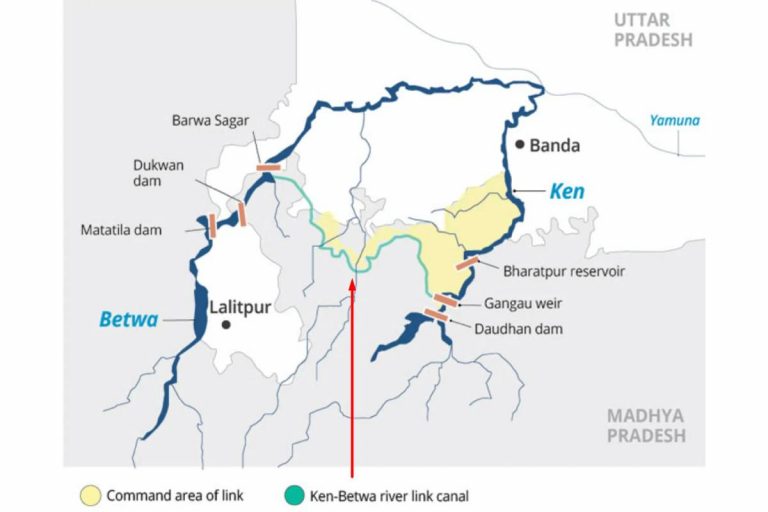
- 09 Jan 2025
Overview of the River Interlinking Concept
The concept of river interlinking in India traces its origins to the 19th century, when Sir Arthur Cotton first proposed inter-basin water transfer to address irrigation issues. Over time, this idea was refined by other experts. It evolved into the National Water Grid and, later, the River-Interlinking Project (ILR) under the Ministry of Water Resources. The goal is to transfer surplus water from rivers to drought-prone areas, aiming for water security, irrigation, and power generation.
Key Projects and Initiatives
- Ken-Betwa River Link Project (KBLP): Launched in December 2024, the KBLP will link the water-surplus Ken River with the drought-stricken Betwa River. It aims to irrigate over 10 lakh hectares, supply drinking water to 62 lakh people, and generate hydropower and solar power. However, concerns over the environmental impact of building a dam within the Panna Tiger Reserve have been raised.
- National River Linking Project (NRLP): The NRLP, formally known as the National Perspective Plan, is an ambitious proposal that includes 30 river links—14 Himalayan and 16 Peninsular—to connect India's rivers and create a giant South Asian Water Grid.
Benefits of Interlinking Rivers
- Flood and Drought Mitigation: Redistributing water from surplus areas to drought-prone regions, such as Bundelkhand, will reduce the severity of floods and droughts.
- Agriculture and Irrigation: Expanding irrigation systems across 35 million hectares of land could significantly boost agricultural productivity and food security.
- Hydropower Generation: The interlinking project has the potential to generate up to 34 GW of hydropower, contributing to India's renewable energy targets.
- Economic Growth: Improving water availability can boost industries, provide drinking water, and support economic development in underdeveloped regions.
- Inland Waterways: The project will also contribute to the expansion of inland waterways, benefiting trade and reducing transportation costs.
Challenges and Concerns
- Environmental Impact:
- Biodiversity Loss: Projects like the Ken-Betwa project raise alarms about the destruction of ecologically sensitive areas, such as the Panna Tiger Reserve.
- River Ecosystem Disruption: Altering natural river courses can harm aquatic life, disrupt deltaic ecosystems, and degrade water quality. For instance, the Sardar Sarovar Dam's impact on the Narmada river system shows the long-term consequences of such projects.
- Pollution: The mixing of cleaner and more polluted rivers could exacerbate water contamination issues.
- Social and Financial Costs:
- Displacement: Large-scale interlinking projects will displace millions, especially marginalized communities and indigenous people, and disturb local livelihoods.
- High Financial Burden: The total estimated cost of the NRLP is ?5.5 lakh crore, which does not include environmental rehabilitation costs or the long-term maintenance of the infrastructure.
- Climate Change: Predictions suggest that climate change could affect river flows and the availability of surplus water. This might render the interlinking project ineffective in the long term.
- Inter-State Conflicts: Water-sharing disputes, like the long-standing issues over the Cauvery and Krishna rivers, could intensify with more interlinking projects.
- Infrastructural Challenges: Maintaining vast canal networks and reservoirs, managing sedimentation, and acquiring land for construction are logistical hurdles.
Alternative Approaches and Solutions
- Efficient Water Management:
- Integrated Watershed Management: Implementing a comprehensive approach to manage existing water resources can reduce the need for large-scale river transfers.
- Groundwater Recharge: Focusing on efficient groundwater management by identifying recharge mechanisms and regulating water use is crucial for sustainability.
- Modern Irrigation Techniques:
- Drip Irrigation: Israel’s success with drip irrigation, which reduces water use by 25%-75%, provides an example of how modern technologies can save significant amounts of water.
- Virtual Water: Emphasizing the import of water-intensive goods (like wheat) could save local water resources, which would otherwise be used for domestic agriculture.
- National Waterways Project (NWP): An alternative to the interlinking project, NWP aims to improve water management by creating navigation channels that double as water distribution networks with a fraction of the land use.
Way Forward
- Comprehensive Impact Assessments: The need for multidisciplinary studies to evaluate the environmental, social, and economic impacts of river interlinking projects cannot be overstated. Stakeholder engagement is crucial for equitable decision-making.
- Sustainable Water Policies: A national water policy should prioritize sustainable water practices, focusing on local solutions, such as water harvesting, watershed management, and smart irrigation.
- Focus on Regional Solutions: Smaller, state-specific projects should be prioritized to address water scarcity issues without triggering large-scale environmental degradation.
The Impact of Climate Change on Earth’s Water Cycle
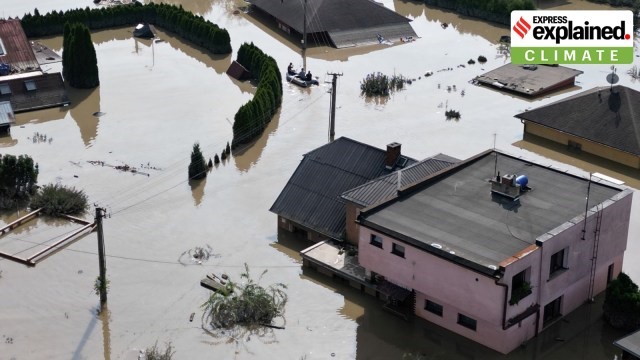
- 08 Jan 2025
In News:
Climate change is significantly affecting Earth's water cycle, leading to extreme weather events such as intense floods and prolonged droughts. According to the 2024 Global Water Monitor Report, this disruption is increasingly evident, as seen in the devastating weather patterns experienced worldwide in 2024. The report, based on data from international researchers, highlights how these changes are directly linked to rising global temperatures and the resulting shifts in precipitation patterns.
Understanding the Water Cycle
The water cycle is the continuous movement of water in various forms—solid, liquid, and gas—throughout the Earth's atmosphere, land, and bodies of water. This cycle involves processes such as:
- Evaporation: Water from the surface of oceans, lakes, and rivers turns into vapor.
- Transpiration: Water is absorbed by plants from the soil and released as vapor.
- Precipitation: Water vapor condenses into clouds and falls as rain or snow, replenishing the Earth's surface.
- Runoff and Infiltration: Precipitation either flows into rivers or infiltrates the soil, contributing to groundwater.
The water cycle is vital for maintaining the planet’s ecosystems, regulating weather patterns, and providing water for all living organisms. However, climate change is intensifying these natural processes, with far-reaching consequences.
Impact of Climate Change on the Water Cycle
As global temperatures rise, climate change is having a profound impact on the water cycle. Warmer temperatures lead to:
- Increased evaporation: As air temperatures soar, more water evaporates into the atmosphere. For every 1°C rise in temperature, the atmosphere can hold about 7% more moisture, which exacerbates storms and increases the intensity of rainfall.
- More intense precipitation: With more moisture in the atmosphere, storms have become more intense, leading to severe flooding in various regions.
- Increased droughts: Warmer air also dries out the soil. This reduces the amount of water available for crops and plants, while also increasing the evaporation rate from soil, leading to longer and more intense droughts.
This disruption of the water cycle is already causing erratic weather patterns, as some regions face severe droughts, while others are experiencing extreme rainfall and floods.
Key Findings from the 2024 Global Water Monitor Report
The 2024 report presents several alarming statistics that highlight the growing impact of climate change on the water cycle:
- Water-related disasters: In 2024, these disasters caused over 8,700 fatalities, displaced 40 million people, and resulted in economic losses exceeding $550 billion globally.
- Dry months: There were 38% more record-dry months in 2024 than the baseline period (1995-2005), underlining the growing frequency of droughts.
- Intense rainfall: Record-breaking rainfall occurred 27% more frequently in 2024 compared to 2000, with daily rainfall records set 52% more often. This shows the growing intensity of precipitation events.
- Terrestrial water storage (TWS): Many dry regions faced ongoing low TWS levels, reflecting the scarcity of water in these areas, while some regions, such as parts of Africa, saw an increase in water storage.
- Future predictions: Droughts may worsen in regions like northern South America, southern Africa, and parts of Asia, while areas like the Sahel and Europe could experience increased flood risks in the coming years.
Conclusion
The findings of the 2024 report underscore the alarming impact of climate change on the global water cycle. As temperatures continue to rise, we can expect more frequent and severe weather events, including extreme flooding and devastating droughts. These changes will affect billions of people worldwide, highlighting the urgent need for action to mitigate climate change and adapt to its consequences. Addressing this challenge requires global cooperation to reduce emissions, enhance water management systems, and protect vulnerable regions from the intensifying effects of climate change.
Introduction to Dr. Manmohan Singh's Economic Reforms
- 31 Dec 2024
In News:
Dr. Manmohan Singh, a distinguished economist, played a crucial role in shaping India’s economic trajectory. His leadership, as Finance Minister (1991–96) and Prime Minister (2004–14), is particularly noted for the economic liberalization and reform policies that transformed India’s economy.
India’s Economic Crisis of 1991
- Economic Collapse: India faced a severe balance of payments crisis, with dwindling foreign reserves and rising inflation.
- Key Challenges: Fiscal deficit, industrial stagnation, and trade imbalances worsened by the collapse of the Soviet Union.
- Urgent Measures: Dr. Singh was appointed Finance Minister during this crisis and initiated bold reforms to stabilize and grow the economy.
Key Reforms in 1991
- Devaluation of the Rupee
- Aimed at making Indian exports competitive in global markets.
- Reduced import tariffs and liberalized foreign trade.
- Industrial Policy Reforms
- Abolition of Licence Raj: Deregulated the industrial sector, promoting private enterprises.
- Reduced state control and encouraged foreign investment, leading to industrial growth.
- Banking and Financial Reforms
- Reduced the statutory liquidity ratio (SLR) and cash reserve ratio (CRR).
- Allowed for more credit flow, fostering economic expansion and banking sector efficiency.
- Global Integration
- Introduced economic liberalization policies, integrating India with the global economy and attracting foreign investments.
Economic Growth and Social Welfare Initiatives
- Poverty Reduction: Reforms helped lift millions out of poverty by fostering job creation and industrial growth.
- Mahatma Gandhi National Rural Employment Guarantee Act (MGNREGA): Launched in 2005, providing 100 days of wage employment to rural households.
- Right to Information (RTI) and Right to Education (RTE)
- Empowered citizens by ensuring transparency and access to government information.
- RTE guaranteed free and compulsory education for children aged 6-14.
- Financial Inclusion: Aadhar project introduced to facilitate welfare delivery and financial inclusion.
Legacy of Economic Liberalization and Growth
- Economic Growth: Under his leadership, India’s GDP grew at an average rate of 8%, establishing India as one of the fastest-growing economies.
- Shift to a Market-Driven Economy: Reforms dismantled socialist controls, facilitating the rise of the private sector.
- Attracting Foreign Investment: Economic liberalization and policy reforms made India an attractive destination for foreign capital.
Leadership During Political and Economic Challenges
- Reluctant Prime Minister
- In 2004, Singh became Prime Minister despite initial reluctance, emerging as a unifying figure during coalition politics.
- His tenure saw India’s rise as a global economic power, particularly from 2004–2009.
- Challenges
- Singh’s second term was marred by allegations of corruption and policy paralysis, leading to criticism of his administration.
- However, his personal integrity remained intact, and he maintained focus on governance.
- Historic India-US Nuclear Deal (2008)
- The deal marked a significant shift in India’s foreign relations and energy policies, enabling civilian nuclear trade.
Conclusion
Dr. Manmohan Singh’s economic policies are central to India's modern economic framework. His vision transformed India from a closed, socialist economy to a vibrant, globalized economy, promoting inclusive growth and institutional reforms. Despite facing challenges and criticisms, his legacy remains a testament to strategic policymaking that continues to influence India’s economic landscape.
Surge in E-Waste Generation in India
- 29 Dec 2024
In News:
India has seen a significant increase in electronic waste (e-waste) generation, rising by 72.54% from 1.01 million metric tonnes (MT) in 2019-20 to 1.751 million MT in 2023-24. The sharpest rise occurred between 2019-20 and 2020-21, driven by increased electronic consumption due to the COVID-19 pandemic's work-from-home and remote learning arrangements.
Environmental and Health Concerns
E-waste contains hazardous substances like arsenic, cadmium, lead, and mercury. If not properly managed, these materials can severely impact human health and the environment, contaminating soil and water sources.
Government Efforts: E-Waste Management Rules, 2022
- Introduction of Extended Producer Responsibility (EPR): The government introduced the E-Waste (Management) Rules, 2022, effective from April 1, 2023. These rules focus on making producers responsible for the recycling of e-waste. Producers are assigned recycling targets based on the quantity of e-waste generated or products sold and must purchase EPR certificates from authorized recyclers to meet these targets.
- Integration of Bulk Consumers: Public institutions and government offices, categorized as bulk consumers, are mandated to dispose of e-waste only through registered recyclers or refurbishers, ensuring proper treatment and recycling of the waste.
- Expansion of E-Waste Coverage: The updated rules expanded the scope to include 106 Electrical and Electronic Equipment (EEE) items from FY 2023-24, up from 21 items previously covered under the 2016 E-Waste Rules.
Challenges in E-Waste Recycling and Disposal
- Low Recycling Rates: Although the share of e-waste recycled in India has increased from 22% in 2019-20 to 43% in 2023-24, a significant 57% of e-waste remains unprocessed annually. Informal sector practices, which dominate e-waste handling, often lack the necessary environmental safeguards, leading to improper disposal and environmental contamination.
- Lack of Infrastructure and Awareness: India faces challenges in building adequate infrastructure for e-waste collection and recycling, resulting in improper disposal in landfills. Furthermore, a lack of public awareness regarding proper disposal methods exacerbates the problem.
Global Context and India’s Position
- India ranks as the third-largest e-waste generator globally, following China and the United States. With an increasing rate of e-waste generation, the country faces an urgent need to improve recycling efficiency and adopt sustainable disposal methods.
International and National Conventions on E-Waste
- India is a signatory to several international conventions that govern hazardous waste management, including the Basel Convention, which regulates the transboundary movement of hazardous wastes, and the Minamata Convention, which focuses on mercury. At the national level, India has established the E-Waste (Management) Rules, 2022, and other frameworks to manage and reduce e-waste effectively.
Strategic Recommendations for Effective E-Waste Management
- Harnessing the Informal Sector: India’s informal sector, which handles a significant portion of e-waste, must be integrated into the formal recycling systems. This can be achieved through training and financial support to ensure safe and environmentally responsible recycling practices.
- Technological Innovations: Encouraging research into advanced recycling technologies, such as AI and IoT-based solutions for efficient e-waste collection and tracking, will be crucial for improving the e-waste management system.
- Learning from Global Practices: Countries like the European Union (EU) and Japan have set strong examples. The EU’s Waste Electrical and Electronic Equipment (WEEE) Directive and Japan’s Home Appliance Recycling Law emphasize Extended Producer Responsibility (EPR) and provide models for India to adapt.
Conclusion
To address the growing e-waste challenge, India must improve its recycling infrastructure, integrate the informal sector, and adopt best practices from international models. With sustainable and effective strategies, India can mitigate the environmental and health risks posed by e-waste while promoting a circular economy.
Free Movement Regime
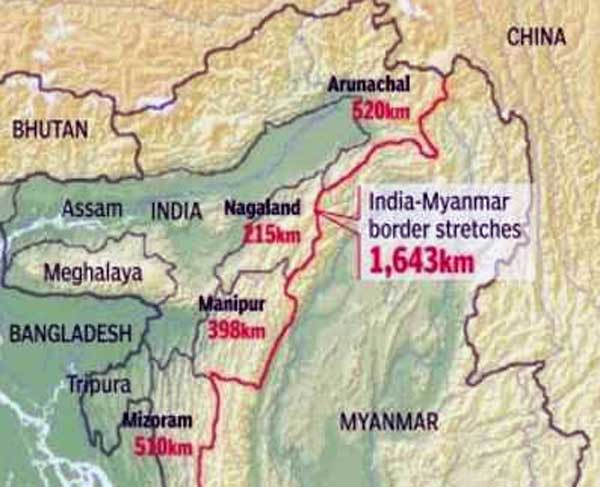
- 27 Dec 2024
In News:
The Indian government, through the Ministry of Home Affairs (MHA), has recently issued new guidelines to regulate the movement of people between India and Myanmar, especially along the border regions. These guidelines come after the suspension of the Free Movement Regime (FMR), which had previously allowed residents within a specified range of the border to move freely. The new protocol aims to enhance internal security and address concerns related to demographic shifts in India's northeastern states.
Background of the Free Movement Regime (FMR)
What is FMR?
The Free Movement Regime (FMR) is a bilateral arrangement between India and Myanmar that permits residents living in border areas to cross the international boundary without a visa. This agreement was established in 1968 to facilitate familial, cultural, and economic exchanges between people living on either side of the border.
Territorial Limits and Evolution
Initially, the FMR allowed free movement within a 40 km radius from the border. However, in 2004, this limit was reduced to 16 km, and additional regulations were introduced in 2016. The most recent development sees the limit further reduced to 10 km, with stricter regulations implemented to regulate the movement.
Recent Developments and New Guidelines
Suspension of FMR
In February 2023, Union Home Minister Amit Shah announced the suspension of the FMR along the India-Myanmar border, citing concerns about internal security and demographic changes, particularly in India's northeastern states. This decision came in the context of growing ethnic violence and political pressures, especially from states like Manipur.
Despite the announcement, the formal scrapping of the FMR is yet to be officially notified by the Ministry of External Affairs (MEA). However, the MHA has issued new guidelines to regulate cross-border movement, focusing on enhancing security without completely discontinuing the regime.
Key Features of the New Guidelines
The updated protocols issued by the MHA include several measures aimed at improving the security and regulation of movement across the border:
- Reduced Movement Limit: The new guidelines reduce the free movement limit from 16 km to 10 km from the border on both sides.
- Border Pass System: Residents wishing to cross into Myanmar or return to India must obtain a "border pass" from the Assam Rifles. This pass allows a stay of up to seven days in the neighboring country.
- Document and Health Checks: Upon entry into India, individuals will undergo a document inspection by the Assam Rifles, followed by security and health checks conducted by state police and health authorities. Biometrics and photographs will be collected, and a QR code-enabled border pass will be issued for verification.
- Designated Entry Points: There will be 43 designated entry and exit points across the border, with biometric verification and health screening required at all points.
- Monitoring and Enforcement: The Assam Rifles will oversee the movement, ensuring that individuals comply with the new regulations. Violations of the movement protocol will result in legal action.
Infrastructure and Technology Implementation
The government plans to establish infrastructure, such as biometric machines and software for border pass issuance. Pilot entry and exit points will be operational soon, with a phased implementation for the remaining points.
Political Reactions and Opposition
Regional Concerns and Opposition
The suspension of the FMR has been a contentious issue in India's northeastern states. The governments of Nagaland and Mizoram have raised objections to the scrapping of the regime, citing the cultural and familial ties of border communities. The Nagaland Assembly passed a resolution opposing the government's decision, while political leaders in Manipur argued that the unregulated movement of people had contributed to ethnic violence in the region.
Specific Concerns in Manipur
The chief minister of Manipur, N. Biren Singh, attributed ongoing ethnic conflicts in the state to the unchecked movement of people across the border. This was particularly evident in the violent ethnic clashes that broke out in 2023. As a result, Singh urged the Home Ministry to cancel the FMR along the India-Myanmar border, and the new guidelines reflect the state's concerns.
Conclusion
The suspension of the Free Movement Regime along the India-Myanmar border, followed by the introduction of stricter guidelines, marks a significant shift in India's border management policy. While the formal scrapping of FMR is yet to occur, the new protocols aim to balance security concerns with the region's long-standing cultural ties. The implementation of biometric checks and designated entry points signifies the government’s focus on modernizing border control while addressing regional concerns. The outcome of this policy shift will have important implications for internal security, demographic dynamics, and bilateral relations between India and Myanmar.
Bank Credit to Women Self-Help Groups (SHGs)

- 21 Dec 2024
Introduction
The Deendayal Antyodaya Yojana – National Rural Livelihoods Mission (DAY-NRLM) is a flagship program by the Ministry of Rural Development (MoRD) that aims to reduce poverty by empowering women, especially through Self-Help Groups (SHGs). These SHGs have been instrumental in improving financial inclusion, providing access to credit, and enhancing the economic and social status of women across India. The program has made significant strides in mobilizing women, improving their access to financial services, and facilitating entrepreneurial ventures in rural areas.
Key Features and Initiatives of DAY-NRLM
- Self-Help Groups (SHGs):
- Formation: DAY-NRLM supports the creation and strengthening of SHGs, primarily focusing on rural women from economically disadvantaged backgrounds.
- Mobilization: As of 2024, over 10.05 crore women have been mobilized into 90.87 lakh SHGs across India.
- Objective: The main goal is to reduce poverty through empowerment by providing access to financial services and sustainable livelihoods.
- Start-up Village Entrepreneurship Programme (SVEP):
- Support for Rural Enterprises: SVEP, a sub-scheme under DAY-NRLM, encourages SHG women and their families to set up small-scale businesses.
- Impact: As of October 2024, 3.13 lakh rural enterprises have been supported under this initiative.
- State-wise Distribution: The program has supported enterprises across various states, with notable contributions from Andhra Pradesh (27,651 enterprises), Kerala (34,569), and Uttar Pradesh (28,904).
- Banking Correspondent Sakhis:
- Role: Women in SHGs are trained as Banking Correspondent Sakhis to enhance access to banking services such as deposits, credit, remittances, pensions, and insurance in rural areas.
- Current Deployment: 1,35,127 Sakhis have been deployed under DAY-NRLM, empowering women to be financial intermediaries in their communities.
- Financial Support for SHGs:
- Revolving Fund: SHGs receive funds ranging from Rs. 20,000 to Rs. 30,000 to boost their operations and financial stability.
- Community Investment Fund: SHGs can avail of up to Rs. 2.50 lakh under the Community Investment Fund to strengthen their financial position.
- Interest Subvention: To make bank loans more affordable, DAY-NRLM provides interest subvention to SHGs, reducing their overall credit costs.
- Online Marketing Platform:
- www.esaras.in: This online platform allows SHGs to market their products, improving their access to broader markets and enhancing their income-generating potential.
Impact of DAY-NRLM and SHGs
- Financial Inclusion: SHGs play a vital role in financial inclusion by providing access to banking services, loans, and insurance to women, especially in rural and remote areas.
- Credit Mobilization: As of November 2024, SHGs have leveraged Rs. 9.71 lakh crore in bank credit, thanks to the capitalization support provided by DAY-NRLM, including Revolving Funds and Community Investment Funds.
- Empowerment of Women: SHGs have significantly contributed to the empowerment of women, providing them with financial independence, social support, and the ability to make decisions in their households and communities.
Challenges Faced by SHGs
- Beneficiary Identification: Ensuring that the most marginalized individuals are included in SHGs can be challenging.
- Training Gaps: There is a lack of quality training programs and expert trainers to build the capacity of SHG members.
- Financial Literacy: Many SHG members have limited knowledge of formal financial services, hindering effective financial management.
- Market Linkages: Poor integration with markets limits the growth potential of SHGs, especially in terms of product sales and business expansion.
- Community Support: Insufficient business environment support and value chain linkages pose challenges to SHG sustainability and growth.
Government Initiatives Supporting SHGs
- SHG-Bank Linkage Programme (SBLP): Launched by NABARD in 1992, this initiative aims to link SHGs with formal banking institutions, facilitating financial inclusion.
- Mission for Financial Inclusion (MFI): A broader initiative to ensure that rural populations have access to affordable financial services such as savings, credit, insurance, and pensions.
- Lakhpati Didi Initiative: Launched in 2023, this initiative empowers SHG women to adopt sustainable livelihood practices and aim for an annual household income exceeding Rs. 1 lakh.
Role of SHGs in Rural Development
- Women Empowerment: SHGs have emerged as a powerful tool for empowering women through financial independence, social security, and the ability to make informed decisions.
- Economic Growth: SHGs foster small-scale entrepreneurship, thereby creating local businesses that contribute to rural economic growth.
- Social Cohesion: By promoting collective action, SHGs provide a social support system that helps in addressing common issues faced by their members, such as health, education, and safety.
Future Prospects and Way Forward
- Technological Integration: SHGs should leverage advanced digital platforms for transaction management, record-keeping, and communication, enhancing efficiency and accessibility.
- Reducing Informal Borrowing: Linking SHGs with formal financial institutions will reduce reliance on informal lenders, promoting financial inclusion.
- Inclusive Approach: SHGs should adopt an inclusive model to ensure that members from diverse socio-economic backgrounds are fairly represented and benefit equally.
- Training and Capacity Building: There is a need for more Community Resource Persons (CRPs) who can guide SHGs in beneficiary identification, financial management, and scaling their activities.
The Costly Push for 100% Electrification of Indian Railways
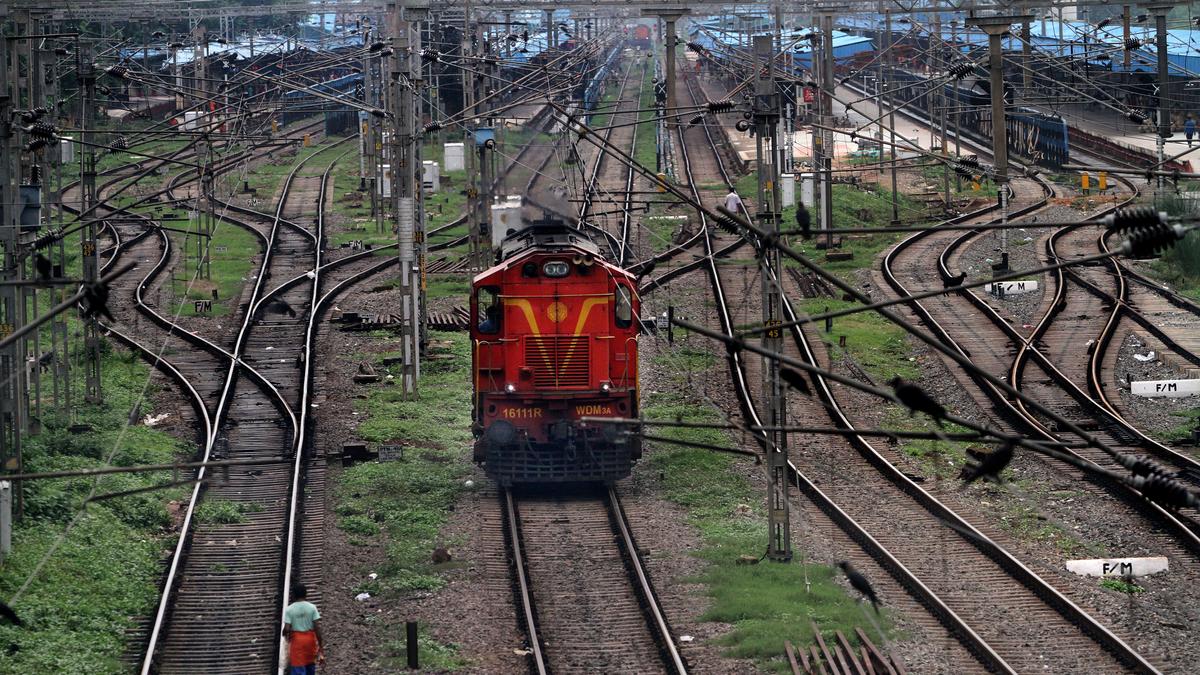
- 19 Dec 2024
Introduction
RITES Ltd., the consultancy arm of the Indian Railways, has secured two contracts to repurpose six broad gauge diesel-electric locomotives for export to African railways. These locomotives, originally designed for India’s broad gauge of 1,676 mm, will be modified for use on railways with the narrower Cape Gauge of 1,067 mm. While this is a commendable re-engineering effort, it also highlights a larger issue within Indian Railways: the unnecessary redundancy of functional diesel locomotives, leading to significant wastage of resources.
The Growing Problem of Idle Diesel Locomotives
As of March 2023, there were 585 diesel locomotives idling across the Indian Railways network due to electrification. This number has now reportedly grown to 760 locomotives, many of which still have more than 15 years of serviceable life. The root cause of this redundancy lies in the government’s mission to electrify the entire broad gauge network at an accelerated pace. This electrification push has resulted in the premature retirement of locomotives that could still serve the network for years, raising questions about the economic and environmental logic behind this decision.
The Justification for Electrification: Foreign Exchange and Environmental Concerns
The Indian government’s electrification drive is often justified on two primary grounds: saving foreign exchange by reducing the import of crude oil and reducing environmental pollution. Additionally, electrification is framed as a step toward a “green railway” powered by renewable energy sources like solar and wind. However, the reality of these claims is more complicated.
Foreign Exchange Savings: A Small Impact on National Diesel Consumption
While electrification may reduce India’s diesel consumption, the impact on national fuel use is minimal. Railways account for just 2% of the country’s total diesel consumption. A report by AC Nielsen in 2014 indicated that the transport sector consumed 70% of the total diesel, with railways accounting for only 3.24%. Even with 100% electrification, the savings in foreign exchange would have little impact on the country’s overall diesel consumption, leaving other sectors like trucking and agriculture as the main contributors.
Environmental Concerns: Shifting Pollution, Not Reducing It
The environmental argument for electrification is also flawed. Electricity in India is still largely generated from coal-fired power plants, with nearly 50% of the country’s electricity coming from coal. Since the Indian Railways is heavily involved in transporting coal, switching from diesel to electric locomotives simply shifts pollution from the tracks to the power plants. This means that the transition to electric traction will not result in a cleaner environment unless the country significantly reduces its reliance on coal. Without a substantial increase in renewable energy generation, the push for a “green railway” remains unrealistic.
The Dilemma of Retaining Diesel Locomotives for Strategic Purposes
Despite the goal of 100% electrification, a significant number of diesel locomotives will remain in service. Reports indicate that 2,500 locomotives will be kept for “disaster management” and “strategic purposes,” although it is unclear why such a large fleet is necessary for these purposes. Additionally, about 1,000 locomotives will continue to operate for several more years to meet traffic commitments. This suggests that even with a fully electrified network, Indian Railways will continue to rely on thousands of diesel locomotives, many of which have substantial residual service life left.
Financial Sustainability and Coal Dependency
The financial sustainability of this transition remains a concern. Currently, the Indian Railways generates a significant portion of its freight revenue from transporting coal—40% of its total freight earnings in 2023-24. If the railways become fully electrified, it will need to find alternative revenue sources, as coal is a primary contributor. Until non-coal freight options can replace this income, the financial health of the railways may be at risk.
Conclusion: Wasted Resources and Unmet Goals
The mission to electrify the Indian Railways, while ambitious, is an example of how vanity projects can lead to colossal waste. Thousands of diesel locomotives are being discarded prematurely, despite their potential to continue serving the network. The environmental and financial justifications for 100% electrification, while appealing in theory, fail to account for the complexities of India’s energy landscape. As a result, the drive to create a “green railway” is likely to fall short, leaving behind a legacy of wasted taxpayer money and unfinished goals.
Arctic Tundra: From Carbon Sink to Carbon Source
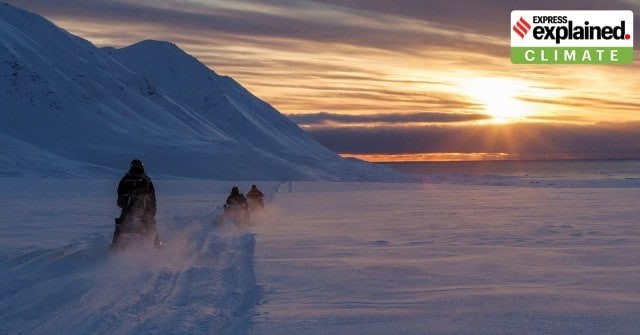
- 18 Dec 2024
In News:
The Arctic tundra, a frozen, treeless biome, has historically been a vital carbon sink, absorbing vast amounts of carbon dioxide (CO?) and other greenhouse gases (GHGs). However, recent findings suggest that, for the first time in millennia, this ecosystem is emitting more carbon than it absorbs, a change that could have significant global consequences. This alarming shift was highlighted in the 2024 Arctic Report Card published by the National Oceanic and Atmospheric Administration (NOAA).
The Arctic Tundra’s Role as a Carbon Sink
The Arctic tundra plays a crucial role in regulating the Earth's climate. In typical ecosystems, plants absorb CO? through photosynthesis, and when they die, carbon is either consumed by decomposers or released back into the atmosphere. In contrast, the tundra’s cold environment significantly slows the decomposition process, trapping organic carbon in permafrost—the permanently frozen ground that underpins much of the region.
Over thousands of years, this accumulation of organic matter has resulted in the Arctic storing an estimated 1.6 trillion metric tonnes of carbon. This figure is roughly double the amount of carbon in the entire atmosphere. As such, the tundra has served as a critical carbon sink, helping to mitigate global warming by trapping vast quantities of CO?.
Shifting Dynamics: Emission of Greenhouse Gases
Recent reports indicate a dramatic shift in the Arctic tundra’s role in the carbon cycle. Rising temperatures and increasing wildfire activity have disrupted the tundra’s balance, leading it to transition from a carbon sink to a carbon source.
Impact of Rising Temperatures
The Arctic region is warming at a rate approximately four times faster than the global average. In 2024, Arctic surface air temperatures were recorded as the second-warmest on record since 1900. This rapid warming is causing permafrost to thaw, which in turn activates microbes that break down trapped organic material. As this decomposition accelerates, carbon in the form of CO? and methane (CH?)—a more potent greenhouse gas—are released into the atmosphere.
The experts, explained the process by comparing thawing permafrost to meat left out of the freezer. Similarly, thawing permafrost accelerates the breakdown of trapped carbon.
The Role of Wildfires
In addition to warming temperatures, the Arctic has experienced a surge in wildfires in recent years. 2024 marked the second-highest wildfire season on record in the region, releasing significant amounts of GHGs into the atmosphere. Wildfires exacerbate the thawing of permafrost, creating a feedback loop where increased carbon emissions contribute further to warming, which, in turn, leads to more emissions.
Between 2001 and 2020, these combined factors caused the Arctic tundra to release more carbon than it absorbed, likely for the first time in millennia.
The Global Consequences of Emission
The transition of the Arctic tundra from a carbon sink to a carbon source is alarming, as it represents a significant amplification of global climate change. The release of additional CO? and CH? into the atmosphere further accelerates the greenhouse effect, leading to higher global temperatures. This warming is already having visible consequences around the world, from extreme weather events to rising sea levels.
If the Arctic tundra continues to emit more carbon than it absorbs, it could significantly exacerbate the climate crisis. The report underscores the urgency of addressing global emissions, as reducing greenhouse gases remains the most effective way to prevent further destabilization of this sensitive ecosystem.
Mitigating the Impact: The Path Forward
Despite the alarming trends, the Arctic Report Card suggests that it is still possible to reverse this process. By reducing global GHG emissions, it may be possible to slow the thawing of permafrost and allow the Arctic tundra to regain its role as a carbon sink. Scientists emphasize that mitigating climate change on a global scale is essential to prevent further emissions from the Arctic ecosystem.
Scientists, stressed the importance of emission reductions, stating, “With lower levels of climate change, you get lower levels of emissions from permafrost… That should motivate us all to work towards more aggressive emissions reductions.”
However, current trends suggest that achieving this goal may be challenging. A recent report from the Global Carbon Project indicates that fossil fuel emissions are likely to rise in 2024, with total CO? emissions projected to reach 41.6 billion tonnes, up from 40.6 billion tonnes in 2023.
How would a carbon market function?
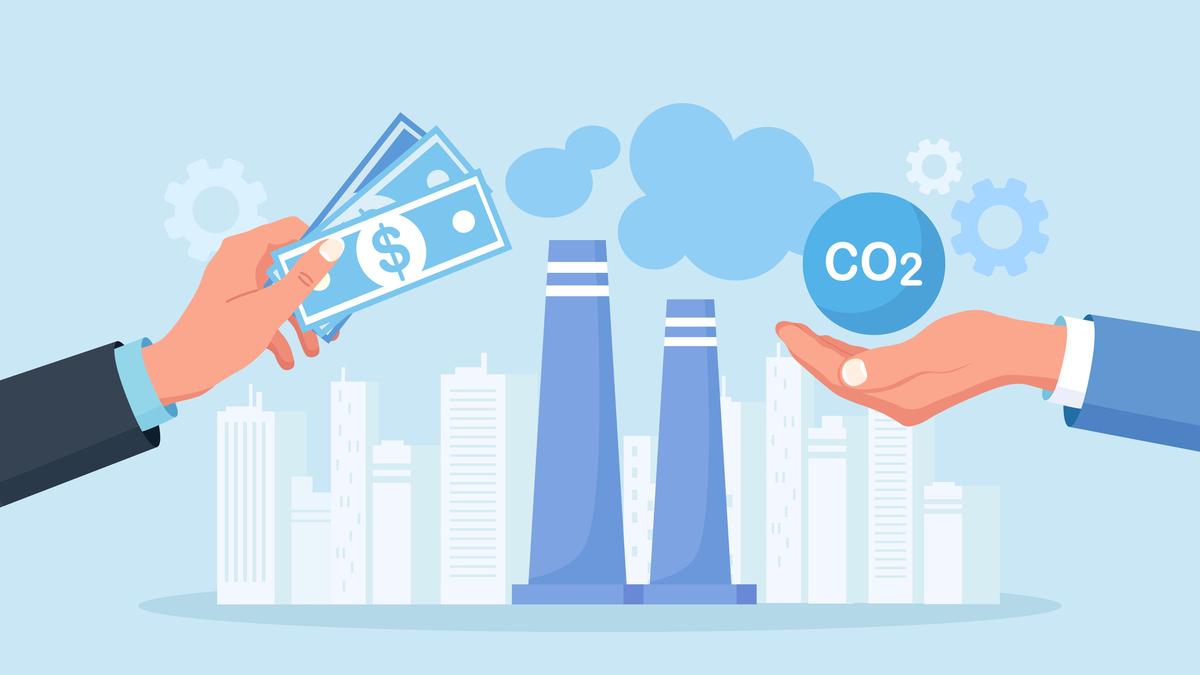
- 16 Dec 2024
In News:
COP29, the ongoing climate conference in Azerbaijan’s capital Baku, has given a fillip to the idea of using carbon markets to curb carbon emissions by approving standards that can help in the setting up of an international carbon market as soon as the coming year.
Introduction to Carbon Markets
- Carbon markets allow the buying and selling of the right to emit carbon dioxide (CO2) into the atmosphere.
- Governments issue certificates known as carbon credits, each representing the right to emit 1,000 kilograms of CO2.
- The total number of credits issued is capped to control carbon emissions. Companies and individuals who don’t have credits cannot emit CO2.
Trading of Carbon Credits
- Carbon Credit Trading: Companies holding more carbon credits than needed can sell them to others who need more, with the price determined by market forces.
- Carbon Offsets: Businesses can also purchase carbon offsets, often provided by environmental NGOs, which promise to reduce emissions (e.g., by planting trees). These offsets counterbalance the firm’s carbon emissions.
- The trading of both credits and offsets is designed to create financial incentives for companies to reduce their carbon footprint.
Advantages of Carbon Markets
- Addressing Externalities: Carbon emissions are a classic example of an economic externality, where the costs of pollution are not reflected in market prices.
- Market Efficiency: By allowing firms to buy and sell carbon credits, the system internalizes the cost of carbon emissions, encouraging businesses to reduce emissions to avoid higher costs.
- Incentive for Emission Reduction: Carbon markets aim to create a financial reason for companies to lower their emissions, thus helping mitigate climate change.
Voluntary vs. Government-Mandated Carbon Markets
- Voluntary Carbon Reporting: Many corporations prefer voluntary systems like the Carbon Disclosure Project (CDP) for reporting their emissions, fearing government-imposed restrictions.
- Market Flexibility: Corporations like ExxonMobil and General Motors argue that carbon markets with freely traded credits allocate carbon allowances more efficiently than government-imposed limits. This allows firms to purchase credits from others, optimizing resource allocation without restricting output.
- Corporate Resistance to Government Intervention: Firms are often reluctant to accept strict government budgets for carbon emissions, fearing increased operational costs and production limitations due to diverse supply chains.
Issues and Criticisms of Carbon Markets
- Government Manipulation of Credit Supply: Governments may increase the number of carbon credits issued, leading to lower prices and reduced incentives for emission reductions.
- Lack of Accountability in Carbon Offsets: Critics argue that some companies buy carbon offsets as a form of virtue signalling, without genuine concern for their environmental impact. This undermines the effectiveness of the offsets.
- Government Mismanagement: Political decision-making may lead to the over-restriction of carbon credits, potentially slowing economic growth by limiting available emissions allowances. The ability of governments to accurately determine the optimal supply of carbon credits is a contentious issue.
The Concept of Carbon Credits and Their History
- Introduction of Carbon Credits: Carbon credits were first introduced in the 1990s in the U.S., specifically through a cap-and-trade model designed to control sulfur dioxide emissions. This approach later expanded to include carbon emissions.
- Role of Carbon Markets: In essence, these markets aim to create a financial mechanism where firms can trade the right to pollute, ensuring a balance between economic growth and environmental protection.
Criticism of Carbon Offsets
- Effectiveness of Offsets: Experts are critical of carbon offsets, arguing that they do not always lead to meaningful reductions in emissions. For example, some companies may purchase offsets without ensuring that the projects are genuinely offsetting their emissions.
- Moral Hazard: Critics suggest that offset programs may lead to firms simply paying for the right to pollute, rather than actually reducing emissions in their operations.
Conclusion
- Carbon Markets as a Tool for Emission Reduction: Despite the criticisms, carbon markets remain a promising tool for mitigating climate change, provided they are carefully regulated and implemented.
- The Future of Carbon Trading: As discussions at COP29 evolve, the development of international standards for carbon trading could potentially enhance the effectiveness of these markets, offering a viable path to global emission reductions.
